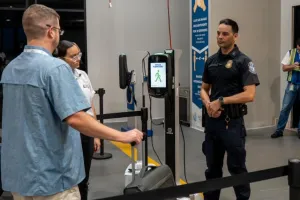
SAN JUAN, Puerto Rico –– U.S. Customs and Border Protection (CBP), in collaboration with Royal Caribbean, conducted the first biometric debarkation for Royal Caribbean cruise passengers on Feb. 2, marking a significant milestone in streamlining cruise operations. Rhapsody of the Seas was the first Royal Caribbean vessel to utilize this technology at the San Juan Seaport’s Pier 4.
CBP’s biometric facial comparison technology streamlines the debarkation process, reducing clearance times by up to 30% and allowing passengers to transition smoothly from ship to shore. On this voyage, Rhapsody of the Seas arrived in San Juan with over 2,000 passengers. While Rhapsody of the Seas has been homeported in San Juan since April 2024, this marks the first time Royal Caribbean has implemented biometric facial comparison technology for cruise passenger debarkation in Puerto Rico.
“At CBP, we believe that every aspect of the cruise experience should be seamless including the arrival process,” said Roberto Vaquero, Director of Field Operations for the CBP San Juan Field Office. “The successful launch of our biometric facial comparison tool marks a significant step forward in securing our nation’s borders. By streamlining the debarkation process for cruise passengers, we empower our CBP personnel to focus on enforcement and protecting our communities. The innovation enhances both efficiency and safety, reinforcing our commitment to national security.”
The process is simple. At debarkation, guests pause at a kiosk equipped with a camera and take a photo. Within seconds, the image is biometrically compared to the documents on file, verifying the passenger’s identity. This seamless process enhances security while ensuring a faster, more efficient debarkation experience.
CBP and its partners are committed to protecting passengers’ privacy. Passengers who do not wish to have their photo taken may request to speak with a CBP officer for alternative identity verification procedures. Additionally, cruise lines do not retain any photos taken during this process and immediately delete them after debarkation.
The successful implementation of this technology for Royal Caribbean in Puerto Rico was made possible through collaboration with CBP, Royal Caribbean, and technology providers. The event was attended by key stakeholders, including Marina Michailaras, Manager of Guest Port Services for Royal Caribbean; San Juan Field Office and Area Port of San Juan leadership.
This initiative underscores CBP’s commitment to modernizing the travel experience while maintaining robust security measures. With the expansion of biometric verification at the San Juan Seaport, travelers can expect a faster, more secure, and hassle-free arrival process.
For more information on CBP’s biometric facial comparison technology and its impact on travel efficiency, visit www.cbp.gov.






